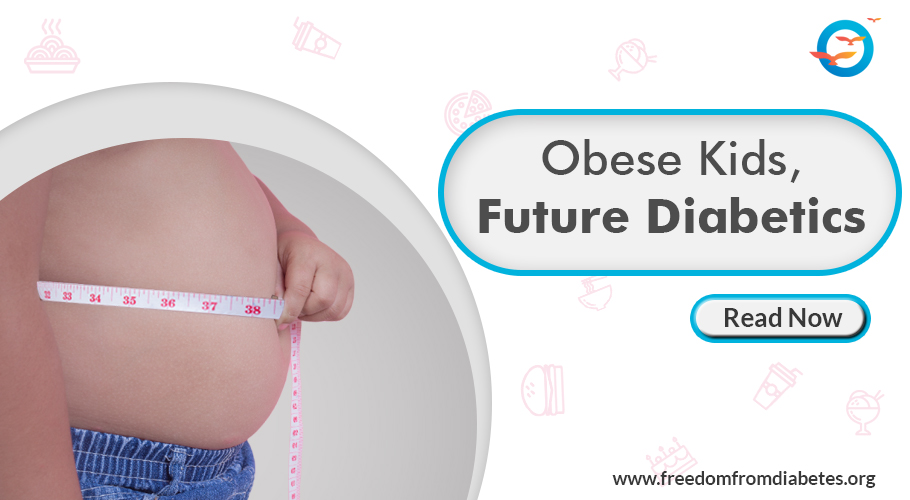Obese Kids, Future Diabetics

Table of Content
- Diabetes Mellitus and Child Obesity
- Causes of childhood obesity
- Prevention & Treatment
3.1 Effective ways to prevent childhood obesity - Parental Role
Are we setting up our children to be diabetic?
Childhood obesity in India has reached epidemic proportions. A study by the National Centre for Biotechnology Information (NCBI) estimates that by 2030, almost thirty percent (27.8% to be precise) of overweight people in the world will be Indians. That’s roughly 5% of the world’s population!
These findings were reiterated by a study, conducted by the Indian Ministry of Health and Family Welfare in 2019-2020. It found a drastic rise in obesity among children below five years of age in 20 out of the 22 states, where the study was conducted. As per the, WHO a BMI of 25+ is considered overweight and 30+ is obese. It’s clear that India is leading this depressing race for global leadership in obesity.
It is no coincidence that India is also leading in the race to become the next diabetes capital of the world. The connection between obesity and metabolic disorders, like diabetes, Blood Pressure, and heart disease, has already been established. So what will the future be like with a massive young but overweight population coming around the bend.
The medical implications are enormous and so are the financial considerations. It is imperative that this problem be tackled at the micro-level, i.e. in every family. But before we look at treatments, let us understand what has caused this situation to begin with.
What are the main causes of childhood obesity?
Childhood obesity has become a serious problem in recent years. There is no single cause of childhood obesity. There are several inter-related factors, including biological, developmental, behavioral, genetic, and environmental ones.
Recent studies also point to epigenetics (the effect of behavior and environment on how genes work) and biological factors like gut microbiome, as factors that are contributing to the growing obese population.
The environment plays a big role, as economic prosperity brings a change in diet from nutritious yet simple fare to modern foods that contain excessive amounts of fat, sugar/salt, and preservatives. Urbanization has also brings a more easy, sedentary lifestyle with low to no physical activity.
1. Nurture or Nature?
If a parent or grandparent is overweight, does it follow that the child too will be overweight? The evidence certainly points in that direction. Overweight or obese mothers are more likely to have children who will be overweight by the time they are four.
This is regardless of their BMI at two. On the other hand, studies show that children born in families where neither parent is overweight are less likely to be overweight. This is of course by no means definitive, as there are many other factors that have a bearing too. For instance: stress.
2. Stress
Children living in a stressful environment are more likely to be overweight than those living with less familial stress.
3. Parental Guidance
The parent’s understanding of the role nutrition and physical activity play are other factors, as are school and community influences, such as access to fast food restaurants, excessive screen time, whereas proximity to parks is known to reduce the risk of being overweight.
4. The Covid Effect
The change in the way we consume data, by virtue of forced lockdowns has increased the opportunity and proclivity to snacking, couch surfing, etc. This lack of activity combined with high screen time, high anxiety levels and boredom have generally increased the consumption of high calorie-low nutrition meals
5. Health Risks of Childhood Obesity
Childhood obesity brings many potential health implications. For instance, obesity during childhood is shown to increase the risk of hypertension, high cholesterol, high triglycerides, and even osteoarthritis.
It also significantly raises the danger of contracting diabetes type 2, coronary problems, stroke, respiratory problems, mental health issues, and some cancers. Little wonder then that India is projected to be the world’s diabetes capital.
Prevention & Treatment
The WHO describes childhood obesity as one of the 21st Century’s most serious public health challenges. If nothing else, just the knowledge of how difficult it is to treat obesity makes prevention of childhood obesity vital.
Here are some simple yet effective ways to prevent childhood obesity:
-
Consuming more fruits and vegetables
Greens are high in nutrients and fibre, and they are also low in calories and carbohydrates. Vegetables like cauliflower and cabbage are potent weight loss foods, as are fruits like apples and pears. Try to get a variety of fruits and vegetables in your diet to ensure you meet the recommended daily intake of vitamins, minerals, and micro-nutrients. -
Minimizing screen time
It’s bad enough that we spend a lot of work/study time in front of our laptops and tablets. TV watching just compounds the problem. Not only does it promote mindless chomping of unhealthy snacks, it also opens children up to TV commercials that promote towards unhealthy foods. -
Lowering sugar intake
Sugar is the chief component of the flavoured beverages children love so well. But it’s frighteningly high in sugar, which as we all know is also highly addictive. Water is a far healthier substitute and should be encouraged. A good preventive measure is to avoid stocking your fridge with sugary drinks. -
Increasing physical activity
Academic pressures and limited time has resulted in less physical activity. Time spend on the playground is a must to combat the effects of unhealthy diets and sedentary living. Parents should encourage their children to get at least an hour every day –playtime in the open air for younger children and vigorous physical activity for older ones.
Parental Role
- Parents are the first—and most enduring—role models that children have. Children see what parents do and behave accordingly; this includes eating habits. Parents who eat more fruits, vegetables, legumes, and whole-grain, and nuts are more likely to have children who have healthy eating habits too.
- Parents should limit the consumption of fats and move from eating foods with saturated fats to poly/monounsaturated fats.
- Milk and milk products should be avoided as far as possible. There are better non-dairy substitutes with a higher and cleaner nutrition palette.
- Cut our or at least reduce consumption of fast foods. These are invariably high in sugar, salt, and fats.
- Cut out snacking entirely. It leads to grazing, which is just a manner of continuous eating. If it is not possible to cut our snacking entirely, try to plan snack time and keep a stock of healthy snacks.
- Avoid forced feeding—it only leads to poor self-control and later obesity. Parents should teach children to eat at regular mealtimes, so this becomes a learned behavior. Do not use food to alleviate boredom or as a reward.

